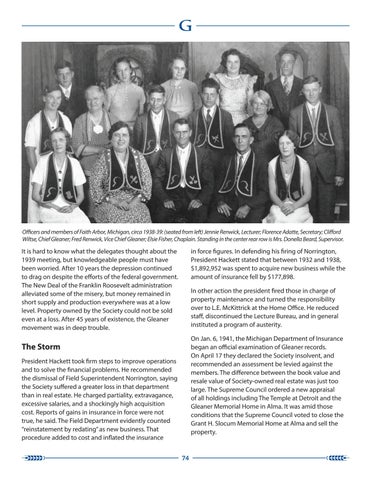Officers and members of Faith Arbor, Michigan, circa 1938-39: (seated from left) Jennie Renwick, Lecturer; Florence Adatte, Secretary; Clifford Wiltse, Chief Gleaner; Fred Renwick, Vice Chief Gleaner; Elsie Fisher, Chaplain. Standing in the center rear row is Mrs. Donella Beard, Supervisor.
It is hard to know what the delegates thought about the 1939 meeting, but knowledgeable people must have been worried. After 10 years the depression continued to drag on despite the efforts of the federal government. The New Deal of the Franklin Roosevelt administration alleviated some of the misery, but money remained in short supply and production everywhere was at a low level. Property owned by the Society could not be sold even at a loss. After 45 years of existence, the Gleaner movement was in deep trouble.
in force figures. In defending his firing of Norrington, President Hackett stated that between 1932 and 1938, $1,892,952 was spent to acquire new business while the amount of insurance fell by $177,898. In other action the president fired those in charge of property maintenance and turned the responsibility over to L.E. McKittrick at the Home Office. He reduced staff, discontinued the Lecture Bureau, and in general instituted a program of austerity. On Jan. 6, 1941, the Michigan Department of Insurance began an official examination of Gleaner records. On April 17 they declared the Society insolvent, and recommended an assessment be levied against the members. The difference between the book value and resale value of Society-owned real estate was just too large. The Supreme Council ordered a new appraisal of all holdings including The Temple at Detroit and the Gleaner Memorial Home in Alma. It was amid those conditions that the Supreme Council voted to close the Grant H. Slocum Memorial Home at Alma and sell the property.
The Storm President Hackett took firm steps to improve operations and to solve the financial problems. He recommended the dismissal of Field Superintendent Norrington, saying the Society suffered a greater loss in that department than in real estate. He charged partiality, extravagance, excessive salaries, and a shockingly high acquisition cost. Reports of gains in insurance in force were not true, he said. The Field Department evidently counted “reinstatement by redating” as new business. That procedure added to cost and inflated the insurance 74




















